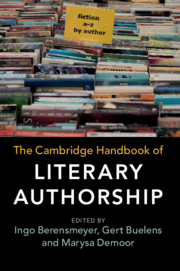Book contents
- The Cambridge Handbook of Literary Authorship
- The Cambridge Handbook of Literary Authorship
- Copyright page
- Contents
- Figures
- Contributors
- Acknowledgments
- Abbreviations
- Chapter 1 Introduction
- Part I Historical Perspectives
- Chapter 2 Authorship in Cuneiform Literature
- Chapter 3 Authorship in Ancient Egypt
- Chapter 4 Authorship in Archaic and Classical Greece
- Chapter 5 Authorship in Classical Rome
- Chapter 6 Conceptions of Authorship in Early Jewish Cultures
- Chapter 7 Modes of Authorship and the Making of Medieval English Literature
- Chapter 8 Manuscript and Print Cultures 1500–1700
- Chapter 9 The Eighteenth Century
- Chapter 10 The Nineteenth Century
- Chapter 11 Industrialized Print
- Chapter 12 Postmodernist Authorship
- Chapter 13 Chinese Authorship
- Chapter 14 Literary Authorship in the Digital Age
- Part II Systematic Perspectives
- Part III Practical Perspectives
- Select Bibliography
- Index
Chapter 2 - Authorship in Cuneiform Literature
from Part I - Historical Perspectives
Published online by Cambridge University Press: 07 June 2019
- The Cambridge Handbook of Literary Authorship
- The Cambridge Handbook of Literary Authorship
- Copyright page
- Contents
- Figures
- Contributors
- Acknowledgments
- Abbreviations
- Chapter 1 Introduction
- Part I Historical Perspectives
- Chapter 2 Authorship in Cuneiform Literature
- Chapter 3 Authorship in Ancient Egypt
- Chapter 4 Authorship in Archaic and Classical Greece
- Chapter 5 Authorship in Classical Rome
- Chapter 6 Conceptions of Authorship in Early Jewish Cultures
- Chapter 7 Modes of Authorship and the Making of Medieval English Literature
- Chapter 8 Manuscript and Print Cultures 1500–1700
- Chapter 9 The Eighteenth Century
- Chapter 10 The Nineteenth Century
- Chapter 11 Industrialized Print
- Chapter 12 Postmodernist Authorship
- Chapter 13 Chinese Authorship
- Chapter 14 Literary Authorship in the Digital Age
- Part II Systematic Perspectives
- Part III Practical Perspectives
- Select Bibliography
- Index
Summary
The ancient Mesopotamian written culture in cuneiform script on clay tablets, beginning about 3000 BCE and disappearing in the early Christian era, offers abundant evidence for authorship, including individual strategies for remembering the names of people who composed specific literary works and statements about how, why, and when they did so.1 These stand out because the authorship of most Mesopotamian literary and scholarly achievements was unknown in antiquity and remains so today; amidst such general anonymity some authors clearly made special efforts to ensure that their claims and experiences continued to be associated with their handiwork. A contrasting artifice, use of a pseudonym, was intended to associate a text with some notable figure of the past who had no role in its composition, even if it seems unlikely in most cases that ancient readers took such an attribution seriously. Cases of authors’ anonymous self-reference and evident presence in the text may also be suggested, as well as apostrophe, or direct address of the author to the reader.
- Type
- Chapter
- Information
- The Cambridge Handbook of Literary Authorship , pp. 13 - 26Publisher: Cambridge University PressPrint publication year: 2019
- 1
- Cited by

